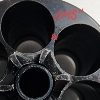Howdy
Here are the actual Sporting Arms and Ammunition Manufactures (SAAMI) specification drawings for the 45 Colt cartridge and chamber.
Notice the on the cartridge drawing the bullet diameter is less than the OD of the cartridge case. This is the case with almost all modern cartridges that have a bullet the same size as the
inside diameter of the cartridge case.
Notice too, the step in the chamber where the diameter is reduced to bullet diameter is not a 90 degree angle. This is because revolver ammunition like this headspaces (seats) on the cartridge rim. There will always be a little bit of space between the end of the cartridge case and the narrower diameter of the chamber throat.

Here are some examples of Heeled Bullets. In other words, the rear of the bullet is slightly smaller in diameter than the rest of the bullet. The 'heel' is the same diameter as the
inside of the case, but most of the bullet is the same size as the
outside of the case. These particular bullets are heeled bullets I cast up for loading in the antique version of the 44 Colt. Has you can see, the outside of the bullets is the same diameter as the outside of the brass. Cartridges like this needed a different type of crimp, the crimp could not be formed with modern style crimp dies. Also, notice one groove for bullet lube is on the outside of the case. This was problematic because the soft lube used in these cartridges would attract contamination from dirt, pocket lint, and what have you.

The 44 Colt cartridge was developed for the Colt Richards Conversion. This Richards Conversion is pictured with 4 original 44 Colt cartridges. The Richards Conversion used the same cylinder as the original Colt 1860 Army Cap & Ball revolver. The cylinders of these revolvers had no narrow chamber throats, the chamber diameter was bored all the way through to where the nipples were located. So, practically speaking, the 44 Colt cartridge was a cartridge designed around a 44 caliber ball. I forget just now what the dimensions are, but I seem to recall the actual bullet diameter of the original 44 Colt cartridges was pretty much the same as 45 Colt, around .452 or so. But the brass was the same diameter as the bullets.

This is the cylinder from the Colt Richards Conversion. The rear of the cylinder, where the nipples were, has been machined away, leaving the .452 or so chambers bored all the way through.

44 Russian, the cartridge all the way on the left in this photo, is generally acknowledged to be the first production cartridge where the entire bullet was the same diameter as the inside of the brass case. The Russians specified this to Smith and Wesson for the Russian model revolvers Smith and Wesson was making for the Russian government. Left to right in this photo the cartridges are 44 Russian, 44 Special, 44 Magnum, and 44-40. All have bullets that are crimped inside the case.

Some more cartridges that had heeled bullets. Left to right, 44 Henry Rimfire, and two examples of 44 Colt. On the far right is an old 45 Colt case. Difficult to see, but the bullet is of the same diameter as the i
nside of the case.

Here is a Smith and Wesson #2 Old Army Tip Up revolver. The cartridges are 32 RImfire. Like most rimfire cartridges, they had a heeled bullet and the outside of the bullet was the same diameter as the outside of the copper case.

Difficult to see in this photo, but the chambers of this revolver were bored through all one diameter. Because the bullets were the same diameter as the copper cases, there was no step for a narrower chamber mouth.



















